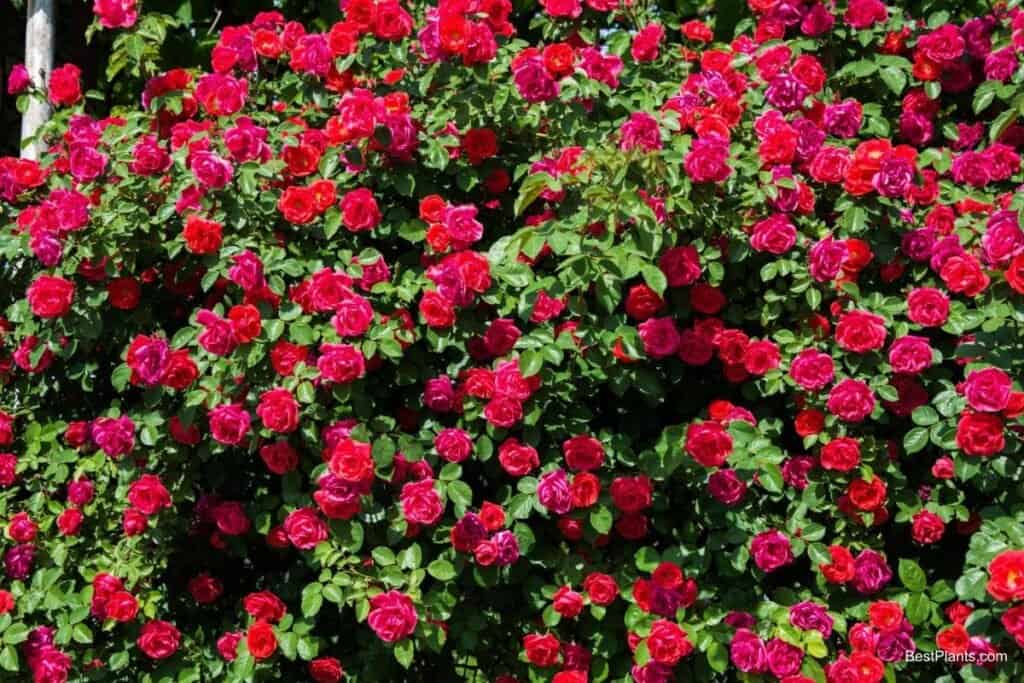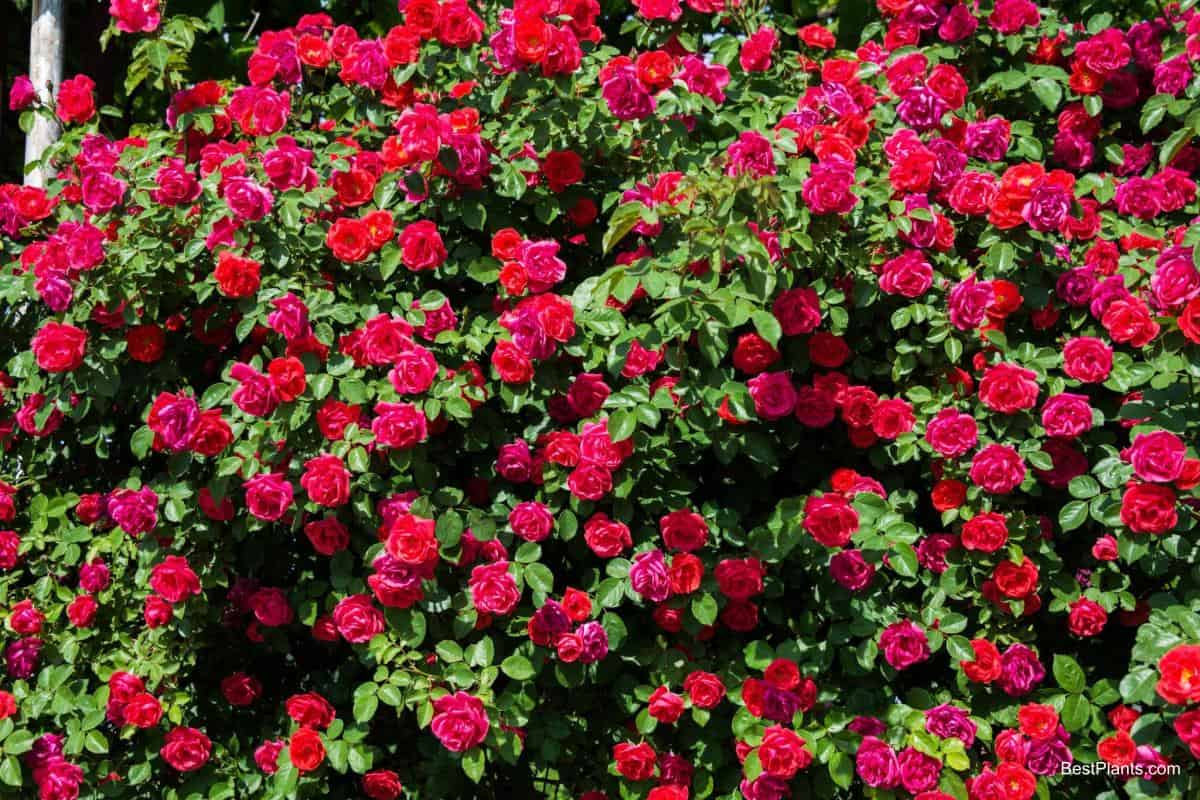In addition to the highly cultivated and often finicky hybrid tea roses, which are so generally prized for the rose garden, many free-growing types are particularly suitable for effective planting in the wild garden, in shrubbery borders, in hedges, and as specimen plants.
The wild or species roses have a charm and elegance in the form, flower, and fruit that make them well worth a place in shrubbery plantings.

Most of the wildlings and many of the single- and double-flowered hybrid varieties of shrub roses are strong and hardy plants.
They will do well with less attention than must be given to most hybrid teas, but they pay extra dividends for good care, including ample nourishment.
Don’t Feed Rosa hugonis
Many will thrive under the same cultural conditions as ordinary, hardy garden shrubs. Some require only a minimum of attention, like the three Rosa hugonis (Father Hugo rose) I planted against the south wall of our sunroom some 15 years ago.
These are pruned only to clean out dead wood and stem borer swellings; they have never been fed (in fact, this rose needs no feeding), and the soil around them has lain undisturbed all these seasons.
Each plant rewards us in mid-May with a six- by eight-foot mass of bright yellow blossoms, and the delicate, fern-like, disease-free foliage persists until frost.
Ushering in the spring with Rosa hugonis, is another yellow-flowered single that makes a good shrub — the hybrid Rosa cantabridgiensis, a cross between Rosa hugonis and Rosa sericia.
It has slightly larger blossoms than the former, the foliage is better, and I think the plant is more shapely.
Another May-blooming rose is Rosa spinosissima altaica. Brought out of the Altai Mountains of Siberia about 1820, this rose has many two-and-one-half-inch single, creamy-white blossoms with yellow centers and dainty foliage. It grows only three or four feet tall.
An accidental hybrid of Rosa moyesi named Rosa highdownensis is another attractive shrub, only one generation away from the wild. It has single, bright crimson flowers followed by large, bottle-shaped fruits in great profusion.
The flower is not unusual, but the fruiting plant against a background of dark green makes a September show worth remembering. Growing to about eight feet tall, the plant is quite shapely.
As a foliage plant, Rosa rubrifolia is the most attractive. It has many dainty, single pink blossoms in June, followed by red-brown fruits, but the plant is generally grown for its graceful, open habit, reddish twigs, and gray-purple leaves.
A native of the mountain area of central Europe, this rose grows better on its roots than when it budded. Also, it does better in partial shade than in full sun.
I found a rose growing in the Arnold Arboretum, which I have started recently in our gardens; it is the Rosa rubrifolia x Rosa rugosa hybrid named Carmenetta. This originated in Ottawa, Canada, in about 1923.
It has clusters of single, pale pink, slightly fragrant flowers and is said to be very hardy. The plant at the Arboretum grows eight feet wide and tall, is furnished with fantastic dark red foliage and many bright fruits and appears free of mildew and black spot.
When considering the value of shrub roses as foliage plants, we should not overlook the rugosas. Everyone knows the beautiful, lusty, leathery leaves of the thousands of rugosa roses blooming along our New England seashores.
The wild rugosas and many of their progeny are reasonably hardy and disease-resistant. Some of them bloom all season intermittently until frost, but the earliest of the hybrid rugosas to bloom in our garden is the six-foot Agnes.
This rose has coppery-yellow buds opening to pale, amber-gold, sweetly fragrant double blooms early in June. Like Agnes, the orange-salmon Vanguard gives only one crop of flowers.
Agnes has rather delicate, light green foliage, but Vanguard has the leathery rugosa foliage and grows to a tremendous plant that may be treated as a shrub or a climber. I like Sarah Van Fleet also, with her buds and flowers of vivid rose pink blooming all summer.
In our garden, she grows to six feet and five feet high, but Walter Brownell has a specimen at Little Compton that is over eight feet across and ten feet tall — a veritable tree.
A Choice Rugosa Hybrid
Conrad F. Meyer is another handsome plant. It is the only hybrid rugosa I have seen with a show rose’s bud form and flower substance. I do not care for the double white rugosas like Blanc Double de Coubert, Schneezwerg, and others.
Their blossoms turn brown as soon as the sun hits them after a wet spell, and the nasty-looking petals hang on until they are picked or knocked off the plant.
The sweetbrier roses (Rosa eglanteria and Rosa rubiginosa) are beautiful plants for the garden that can be appropriately protected against rose diseases.
Nothing is comparable to the delicate, wine-like odor that the gentle morning breezes carry through the park from the delightfully aromatic foliage of the sweet briers.
The Penzance sweetbrier hybrids range from three-foot shrubs to twelve-foot trees, and their foliage may be large and dark green, as in Greenmantle, or dainty and delicate, as in Lady Penzance.
These hybrids are apt to grow too large for most gardens — besides which most sweetbriers seem susceptible to black spots and need attention to keep them in foliage.
The Rosa rubiginosa x Rosa gymnocarpa cross we picked up a year ago seems to be a more disease-resistant plant than its sweetbrier parent. It has not lost any of its foliage perfume in the crossing. It is a gorgeous, five-foot specimen.
One of the most breathtaking shrubs in the garden is a well-grown plant of Austrian Copper. This rose, Rosa foetida bicolor, and the yellow Rosa foetida lutea from which it sported, both make large, open plants that grow to eight feet tall.
The yellow variety is beautiful in its own right, but the rose that excites exclamation is the Rosa foetida bicolor. Its two-inch, single blossoms are a bright orange-scarlet on the face of the petals and a bright yellow on the reverse.
With bicolored bloom covering both the plant and the ground beneath it, this species is a sight worth journeying to see. I have seen this rose doing fairly welt in windy spots where it received little or no attention.
On the other hand, it is notoriously susceptible to black holes and must be sprayed regularly to keep it in foliage. It. should never be planted in a small rose garden where the air is sluggish.
Harison’s Yellow
Harison’s Yellow is one of the earliest American originations and a fairly disease-resistant old rose worth growing in any garden. Bud-grafted on Rosa multiflora stock to keep it from suckering, this plant will grow to a beautiful 6′ or 8′ feet — often making a giant plant on its roots.
This long-lived plant gives a profuse June bloom of semi-double, bright yellow flowers. It has small, rich green foliage and is quite hardy.
Down in Bristol, Rhode Island, on the Lyon estate, is the most enormous rose bush (or tree) I have ever seen.
It is ancient and has grown to nearly twenty feet in height, and 15′ feet across — an excellent specimen of the single-flowered form of Rosa Roxburgh normalize, commonly called the chestnut rose.
Miss Willmott, in GENIUS Rosa, calls this plant Rosa microplylla and says it has large single red flowers, but those at Bristol Nurseries are pinkish.) The buds and fruits resemble small chestnut burs. It is reputed to be easy to propagate from seed or suckers.
The easiest plant to grow as a shrub in the hybrid perpetual class is Frau Karl Druschki. If this beauty is given a reasonable amount of care plus a little feeding, it will stretch to six feet each way with a profusion of large, double, white blooms in June and again in the fall.
The English method of pegging down the long shoots in the early spring will cause the plant to throw blossoms all along the canes.
The old Bourbon rose, Zephirine Drouhin, and the newer Gypsy Boy (Zigeuner Knabe) are both exciting plants. The first is thornless, with eight-foot arching canes and shapely, fragrant, cherry-pink blossoms, bearing heavily in June and intermittently until frost.
If the plant is fed and kept shortened to 4′ or 5′ feet, it will bloom almost continuously. Gypsy Boy, although blooming only once, makes a 6’ plant with an extraordinary quantity of bloom early in June.
The medium-sized, double, and very dark purple flowers grow in significant clusters throughout the plant.
Related: Learn To Make Use Of Under Appreciated Shrub Roses
Outstanding New Hybrid
Among the newer shrub roses are a group of hybrids of Rosa spinosissima, originated by Kordes in Holstein, West Germany. Of those introduced, Fruhlingsgold (Spring Gold) seems the best.
A 6′ by 6′ foot plant of arching habit and attractive foliage, it blooms in early spring soon after Rosa hugonis and its associates. Covered with semi-double, clear yellow blooms, this plant was worthy of the R.H.S. Award of Merit in England in 1950. It’s one fault that it is not entirely disease-resistant.
The hybrid musk roses are another source of good shrubs. Most of them bloom heavily in June and then intermittently until frost. They are usually shapely plants from four to 6’ feet tall, not very susceptible to disease.
The Kordes hybrids Eva, Skyrocket (Wilhelm), and Will Scarlet seem the easiest to grow. All three have reddish blossoms in large trusses, dark green foliage, and vigorous growth.
William Kordes, who originated these roles, says that the hybrid musks will winterkill at temperatures below 0° degrees Fahrenheit. Still, ours have come through five or six below zero with but minor damage.
Related: How To Protect Your Roses In Winter
Of the Pemberton musks, we have found that Penelope (pink) and Prosperity (cream) seem to be the best plants. The latter is reputed to grow to six feet, but ours has never exceeded four feet.
44659 by Karl P. Jones
